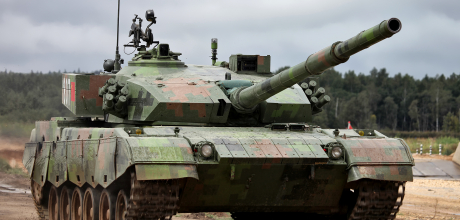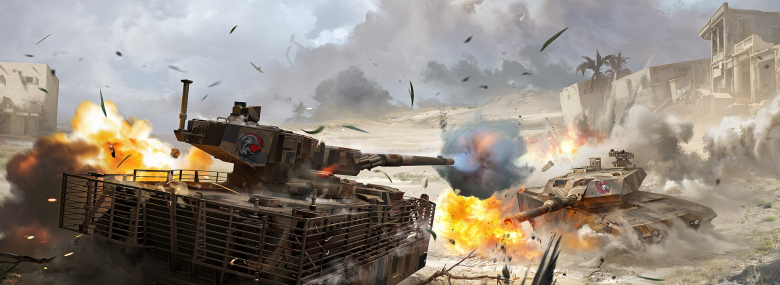
Commanders!
In the last part of our Developer Diary series, we took a look at the Main Battle Tanks and their role in Armored Warfare. Today, we’ll discuss another hotly debated class – the Armored Fighting Vehicles.
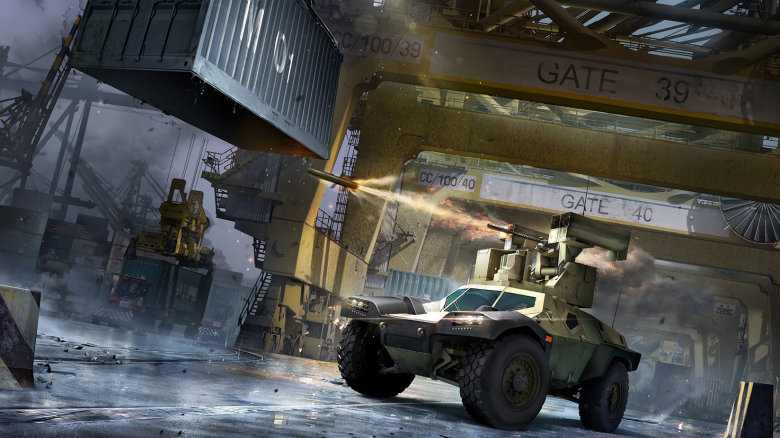
Defining the Armored Fighting Vehicle group based on real life characteristics is not an easy task. Unlike the Main Battle Tanks that are relatively clearly defined, “Armored Fighting Vehicle” is a name that can – at least in real life – consist of pretty much any armored vehicle that’s designed for battle, including tanks.
This makes the class name arbitrary to a degree, but then again, so are the real life vehicle designations in many cases. In Armored Warfare, the only classes that are clearly defined based on their real life role are the Main Battle Tanks and the Self-Propelled Guns (that consist of vehicles designed primarily with indirect fire in mind), while the Light Tanks, Tank Destroyers and Armored Fighting Vehicles are in some cases interchangeable.
Let us therefore not burden ourselves with the chaos of real life nomenclatures and simply say that the AFVs are, generally speaking, the lightest vehicles of Armored Warfare with their weight rarely exceeding 20 tons. The protection levels reflect this fact – while some AFVs do in fact have some advanced countermeasures, they are the least protected vehicles in the game. They are commonly armed either with an autocannon or a combination of autocannon and guided missiles.
To compensate for the lack of main caliber weaponry and armor, the AFVs are fast – the lightest AFVs such as the CRAB are also the fastest and best accelerating vehicles in the game. This makes them very hard to hit, but their true strength lies in their ability to hide.
The AFVs are not just light, they are in many cases also small and the smaller a vehicle gets, the harder it is to detect. The AFVs are exceptionally good at staying hidden while seeing the enemy thanks to their advanced electronics and optics – they have the best viewrange of all classes in the game. This is called scouting or spotting. You can read more about the spotting tactics in the AFV Battlefield Role part of this article and in our recent developer diary.
Special Ability
The Armored Fighting Vehicles have a special ability that can be activated by pressing the E key called Designate Target. When activated, the target under your aim reticle becomes designated for you and other friendly players on the battlefield for a short period of time. Designated targets are unable to hide and will remain spotted. Designated targets also take additional damage when fired at. This ability can be used to single out the most dangerous opponents on the battlefield to allow your teammates to destroy them.
Classification
There are two basic ways of classifying the AFV class. For starters, it can be split into:
- Tracked Vehicles
- Wheeled Vehicles
While self-explanatory, this classification doesn’t tell much about the vehicles themselves save for some of their mobility aspects. Wheeled vehicles are much faster on hard surfaces such as roads, while tracked vehicles are not as fast in general, but are considerably faster and more mobile off-road, especially in the roughest terrain. There are, however, some exceptionally fast tracked vehicles as well as some wheeled vehicles that are not as fast or nimble as their tracked counterparts. It is therefore better to focus on their role on the battlefield instead of their means of mobility. Based on their roles, the AFVs can be split into:
- Light AFVs
- Heavy AFVs
Light AFVs
Light AFVs typically include very light tracked vehicles, four-wheeled vehicles and six-wheeled vehicles – in real life these are often dedicated recon vehicles or vehicles used by Special Forces. Examples include:
- LAV-150
- FV721 Fox
- OT-65A
- VBL, VBR and CRAB (four-wheeled French light AFV)
- BMD series (tracked Russian light AFVs)
Top vehicle:
- SPHINX (Tier 10 AFV)
Several small and agile vehicles – most notably the Wiesel family – was moved from the AFV class to the Tank Destroyer class in Update 0.19 to better reflect their nature.
Of all the vehicles of Armored Warfare, these generally carry the least amount of firepower for their Tier. Their armament varies widely and also determines their play style. For example, the LAV-150, as a low-Tier vehicle, is only armed with an autocannon. The Fox, VBR and CRAB AFVs are armed with a combination of an autocannon and guided missiles while the VBL is only armed with guided missiles. BMD series on the other hand typically carry excellent firepower for their Tier that includes low muzzle velocity cannon or an autocannon and guided missiles both.
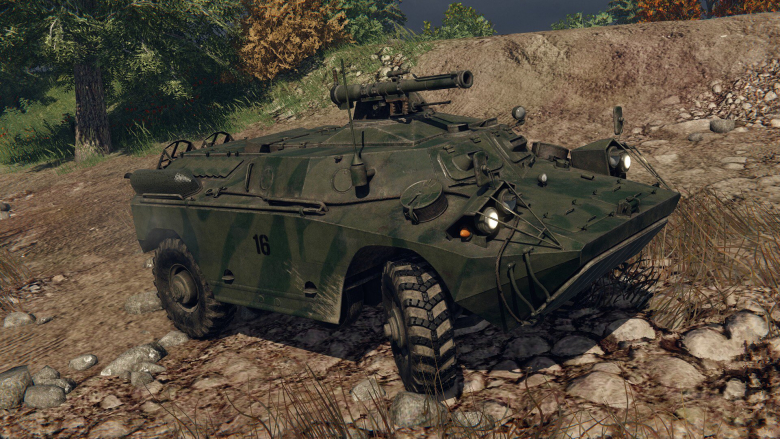
Light AFVs are, hands down, the best scouts in the game. Whether staying hidden behind a bush and observing enemy vehicles at distance or using their high speed and maneuverability to quickly spot the enemies and disappearing behind an obstacle before they have a chance to react, the light AFVs are the ultimate eyes and ears of each team. No vehicles are as good at this and a single capable scout can turn the tide of battle in your favor, especially if the enemy team lacks an equally skilled spotter.
Their mobility is also second to none with nearly instant acceleration – some of the wheeled vehicles might be a bit difficult to control due to all that speed but once you get the hang of it, you’ll be taking turns as if there was a fresh batch of tofu in your trunk waiting to be delivered. The most important part, however, is to be aware of your environment – being stopped by running into an obstacle in the middle of a dogfight will surely lead to your quick demise.
However, there’s a price to all this speed and influence. The Light AFVs are, hands down, the most fragile vehicles in the game and even a single hit from anything bigger than an autocannon can deal massive damage, immobilizing you, killing the crew or destroying multiple modules. High Explosive shell hits are especially devastating since their explosive splash makes it much easier to immobilize an AFV by destroying its wheels or tracks. A static and spotted AFV is a dead AFV – this is especially important for players who prefer to stay hidden rather than run around the battlefield. It is crucial to immediately relocate when spotted, as everyone and their grandmother will instantly target you as an easy kill.
Regardless of what weapons systems they use, the Light AFV firepower is also quite low and their fire support ability will always be inferior to other classes. AFVs armed with guided missiles can take out a MBT with some luck and careful aiming but their autocannons are only useful against other light and unarmored targets. If attempting to score some kills, missile-carriers like the VBL should therefore stay away from the front line. Vehicles relying on autocannons should, on the other hand, close in and take out their targets by firing at exposed enemy flanks.
If you prefer a combination of stealth and speed, like to silently wait in hiding, to mark your enemies and drive them mad by the fact they can’t see you and you like to have a lot of influence on the flow of battle, the light Armored Fighting Vehicles are the best class for you. Be warned though – they are possibly the most difficult vehicles to play in all of Armored Warfare. Mastering them requires not only solid knowledge of game mechanics, but also careful planning and the ability to read the battlefield.
Heavy AFVs
These vehicles generally consist of eight-wheeled and tracked IFVs. Examples include:
- BMP series
- Šakal and KTO Rosomaks
- Bradley IFV
- Warrior IFV
With the OA-82 Jarmila II and OT-64 COBRA coming in Update 0.22. Previously, the heavy AFVs also include the Terminator vehicle family, but they were moved to the Tank Destroyer class since that’s what they are used the most on the battlefield.

Heavy IFVs lie in their role somewhere between the Light AFVs and the Light Tanks. On the scale of mobility, they are second only to the Light AFVs, especially on hard surfaces, with the scale itself looking roughly as such (from the highest mobility class to the lowest):
- Light AFVs
- Heavy IFVs
- Light Tanks
- Tank Destroyers
- Main Battle Tanks
- Self-Propelled Guns
The armament systems are generally identical to the Light AFV class but are better stabilized (increased accuracy on the move) or can fire faster. Heavy AFVs are also larger and have more hitpoints with some of the vehicles featuring quite solid protection, rivaling that of the Light Tanks – for example, the Bradley and the BMP-3 both carry an ERA kit. The Bradley can also equip a soft-kill APS, while the Warrior carries relatively thick additional armor plating in the form of the TES(H) kit. This armor, however, should not be generally relied upon as main caliber weapons and guided missiles will penetrate it quite easily.
While they are still AFVs and are fully capable of scouting, Heavy AFVs typically don’t carry the Recon Package module of the light AFVs that reduces the spotted indicator feedback time and increases vehicle viewrange when standing still. Additionally, they are usually much larger, a fact that considerably reduces their camouflage factor. These two drawbacks make them considerably worse at passive spotting – they are too conspicuous to successfully stay hidden behind a bush and have to rely on their speed and agility.
The Heavy AFVs are suitable for you if you prefer more mobile playstyle compared to the Light AFVs. Mobility and speed is everything – circle around your opponents and hit them where it hurts – areas such as the engines decks and vehicle flanks are especially vulnerable to AFV cannon fire. Or keep your distance and use your missiles to take the enemies out, but your main role on the battlefield will still be scouting.
Armored Fighting Vehicle Battlefield Role
As was stated above, the primary role of the Armored Fighting Vehicles in Armored Warfare is scouting, or spotting (both terms are commonly used). Spotting is the act of making the enemy vehicles visible for your entire team so that vehicles that are further away or do not have the best spotting abilities can target them.
There are essentially two kinds of spotting:
- Active spotting, where a vehicle uses its speed to spot the enemy while avoiding incoming fire
- Passive spotting, where a vehicle attempts to stay hidden for as long as possible by standing still
While the Light Tank class is suitable for active spotting, the AFVs excel at both – in fact, spotting is their primary purpose. Light AFVs are best at passive spotting (staying hidden behind bushes), Heavy AFVs are best at active spotting – only the Light Tanks come close.
The most important skill, when playing AFVs of any type, is to read the flow of battle and to understand your surroundings. As was stated above, a stopped or slowed and spotted AFV is a dead AFV – there are practically no exceptions to that rule since the fragile vehicles represent a juicy target.
The basic short-range combat technique is called circling. Auto-locking your gun on the enemy at short range allows you, thanks to your mobility and fast turret traverse, to stay focused on driving and firing while the gun points at the enemy flanks and rear. This way, you can drive in circles around heavy enemies such as MBTs and they won’t be able to follow you. This tactic is especially suitable for dealing with targets that your gun would otherwise be unable to penetrate like the Challenger – targeting its rear is a must when using your autocannon. Beware, however – nimble targets such as Light Tanks, other AFVs and some Tank Destroyers will be able to track you even when you attempt to circle them and a head-on firefight is not something any AFV can afford to participate in.
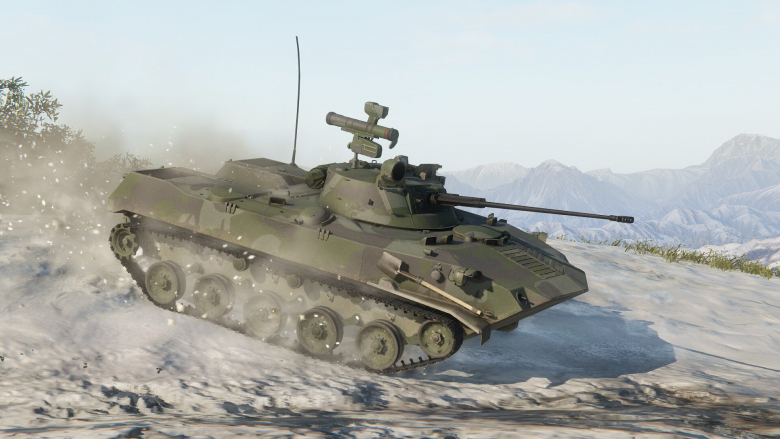
Heavy AFVs are exceptionally good at hunting Light AFVs thanks to their increased durability, protection, firepower and decent spotting abilities. Marking an enemy AFV with your special ability will definitely ruin his day.
Another essential skill is to learn of all the proper spotting areas on each map. The key is to find a place with the following properties:
- Good vantage point over areas where the enemies are expected to show up
- Plenty of cover and foliage to hide you
- Accessible route of retreat
The last point should not be underestimated – when discovered, you only have a second or two to react while the enemy is still targeting you. The best tactic is to stay in cover with the front of your hull aimed at the retreat route – this way, running away is only a matter of going forward instead of wasting precious second to turn.
Truly mastering the AFV class requires patience and experience with the game and a lot of practice – the reward is driving perhaps the most frustrating class of vehicles to defeat. It is, therefore, the right choice for players who truly want to make other players hate them as an extremely skilled player in an AFV is perhaps the most difficult kind of opponent to kill in the entire game.
Future plans for Armored Fighting Vehicles
Our main goal for the future is to make the Armored Warfare classes more diverse and different from each other.
Perhaps the most important change we have in store for the AFV class is the wheeled vehicle control overhaul, coming in Update 0.22. This is a series of smaller changes that will – as a whole – make especially the lightest wheeled vehicles much easier to control. The vehicles affected by this change will be (amongst others):
- CRAB
- FV721 Fox
- LAV-150
- SPHINX
Other vehicles affected by this change (such as the Stryker or the ERC 90) will be discussed in the upcoming Tank Destroyer article.
The mobility of all classes will be overhauled as a whole. We already discussed the MBT mobility changes in the MBT Developer Diary article. In the new system, the AFVs will still remain the fastest vehicles with the best acceleration (which will be approximately 50 percent higher than the LTs) and the highest average speed (which will be approximately 30 percent higher than the LTs).
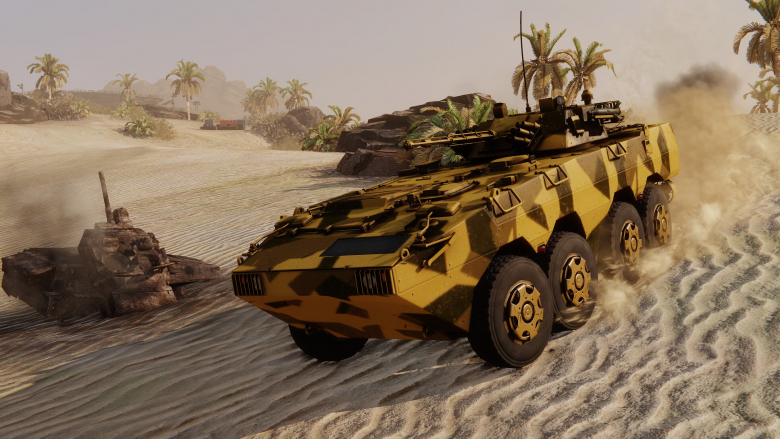
Other AFV changes are related to their ability to remain hidden. We’ll take a look once again at the bushes and the camouflage factor they provide. We will also make the Special Ability easier to use – it will apply faster and will not require as precise targeting as it does now. High-Tier (Tier 8 and higher) autocannons will be buffed as a whole. This will return the ability of AFVs to damage MBT sides and rears more reliably, making circling a viable tactic once again.
Major changes to the Commander system will allow players to better configure their commanders to suit their gameplay style, which includes spotting.
And last but not least, we will of course introduce new progression AFVs in the future, such as the ZBL-08, coming in Update 0.22, or various light vehicles coming in Update 0.23, which will be unveiled later.
We’ll see you on the battlefield!




